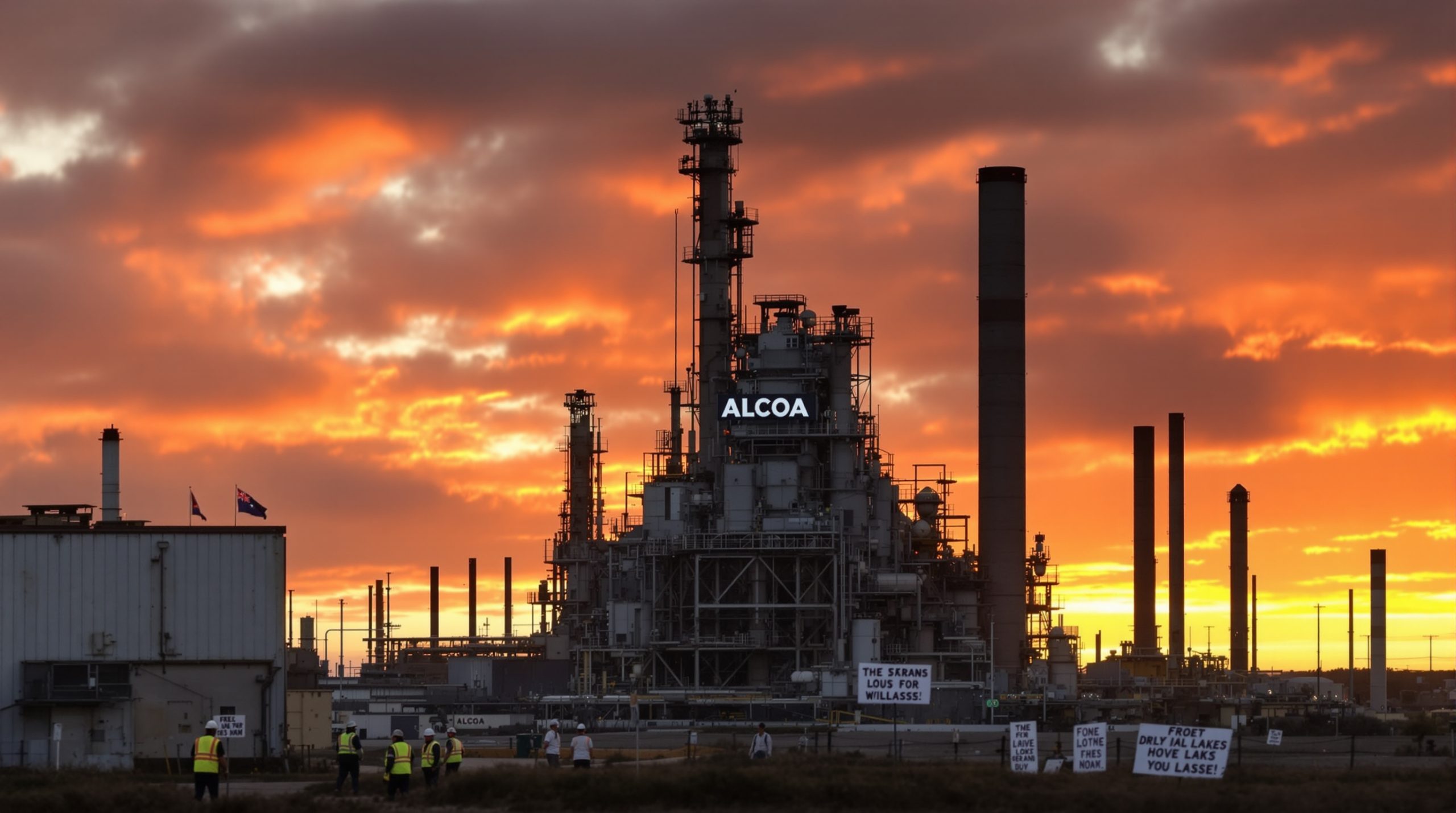I'll insert the internal links naturally into the article while maintaining its original structure and formatting.
What Led to the Permanent Closure of Alcoa's Kwinana Refinery?
The permanent shutdown of Kwinana alumina refinery marks the end of an era for one of Western Australia's longest-standing industrial operations. After more than six decades of operation, Alcoa's decision to permanently close the facility stems from a complex mix of economic realities and operational challenges that rendered the refinery unsustainable in today's competitive global market.
Economic and Operational Challenges
The Kwinana refinery faced mounting pressures that ultimately led to its closure, including significant aging infrastructure issues. Having operated continuously since the 1960s, the facility required substantial capital investment to maintain competitive operations in today's market environment.
Rising operational costs presented another significant challenge. The energy-intensive nature of alumina refining made the facility particularly vulnerable to increasing power costs in Western Australia, creating an unsustainable cost structure compared to newer, more efficient facilities worldwide.
The quality of available bauxite resources also played a role in the closure decision. As local bauxite deposits changed in composition over decades of mining, the refinery faced efficiency challenges in processing this evolving raw material.
Global market conditions further compounded these issues. The aluminum industry has experienced significant restructuring globally, with production increasingly concentrated in regions with lower energy costs and newer infrastructure. This placed older facilities like Kwinana at a competitive disadvantage despite its historical importance.
Scale limitations compared to newer refineries also contributed to the closure. Modern alumina refineries typically operate at significantly larger scales, achieving economies that the Kwinana facility, despite its 2.2 million tonne annual capacity, could not match.
Timeline of the Shutdown Decision
The closure process began in January 2024, when Alcoa initiated workforce reductions at the Kwinana facility. This marked the beginning of a phased approach to winding down operations.
Initially announced as a production curtailment, Alcoa framed the move as temporary while it evaluated options for the facility's future. Throughout 2024, the company conducted a comprehensive assessment of restart viability, examining market conditions, operational costs, and capital requirements.
By September 2025, after exploring multiple scenarios, Alcoa confirmed the permanent closure. According to Alcoa's Chief Operations Officer Matt Reed, the company "made the difficult decision to permanently close the facility after unsuccessfully exploring multiple options for a sustainable path to restarting."
The complete shutdown process is expected to extend through 2026, with a gradually diminishing workforce remaining to manage the decommissioning process. Beyond 2026, a small contingent of employees will continue working to prepare the site for future redevelopment opportunities.
How Significant is the Economic Impact of the Kwinana Closure?
The permanent shutdown of Kwinana alumina refinery represents a substantial economic blow to Western Australia, with ripple effects that will be felt throughout the regional economy for years to come.
Employment and Workforce Consequences
The human impact of the closure is perhaps the most immediate and visible consequence. At the start of 2024, the Kwinana refinery employed approximately 800 workers. By September 2025, this workforce had already been reduced to around 220 employees as part of the initial curtailment.
According to Alcoa's announcements, this workforce will continue to be gradually reduced as the decommissioning process advances through 2026. Only a skeleton staff will remain to oversee site preparation and potential redevelopment activities.
The job losses extend well beyond direct employees. When accounting for contractors, maintenance services, logistics providers, and other support services, the total employment impact likely exceeds 1,000 positions. These roles often featured specialized aluminum industry skills that may not be easily transferable to other sectors without significant retraining.
Many affected workers possess highly specialized knowledge in aluminum processing, skills that have limited application outside the resource processing sector. This creates additional challenges for workforce transition in a region already facing industry consolidation pressures.
Financial Impact on Western Australia
Economic analysts have quantified the closure's impact on the broader economy, with estimates placing the annual reduction to Western Australia's economic output at approximately $650 million. This figure represents not just the direct value of alumina production but also the multiplier effects through supply chains and consumer spending.
The closure will result in significant tax revenue losses at both state and federal levels. Resource processing facilities like Kwinana generate substantial payroll taxes, corporate taxes, and various fees and global taxes & royalties that support government services.
The Kwinana industrial area, one of Western Australia's most important manufacturing hubs, will experience reduced economic activity as a result of the closure. The refinery served as an anchor tenant that supported numerous smaller businesses in the region.
Downstream effects on local businesses and service providers will be substantial. From equipment suppliers to maintenance contractors, transportation services to local retailers, many businesses in the surrounding communities relied on the refinery and its workforce as key customers.
The property market in surrounding residential areas may also experience downward pressure as displaced workers potentially relocate for new employment opportunities.
Regional Community Effects
| Community Aspect | Impact Assessment | Details |
|---|---|---|
| Local employment | Severe | Major employer in region with specialized positions difficult to replace |
| Supply chain businesses | High | Many local businesses derived significant revenue from refinery operations |
| Municipal tax base | Moderate | Reduced industrial tax contributions affecting local government services |
| Housing market | Potential downward pressure | Possible reduced demand in nearby suburbs as workers relocate |
| Social services demand | Likely increase | Displaced workers may require additional support during transition |
The social fabric of communities surrounding the Kwinana industrial area will face significant challenges as the closure impacts local schools, community organizations, and social networks that were supported by the refinery workforce and their families.
What Does This Mean for Australia's Aluminum Industry?
The permanent shutdown of Kwinana alumina refinery represents a significant shift in Australia's aluminum sector landscape, with implications that extend across the national industry and affect Australia's position in global aluminum production.
Production Capacity Changes
The closure results in a 16% reduction in Alcoa's global refining capacity, decreasing from 13.9 million tonnes to 11.7 million tonnes annually. The Kwinana refinery's 2.2 million tonne annual alumina production capacity represented a significant portion of Australia's total output.
While Australia maintains its position as the world's largest bauxite producer, the Kwinana closure affects the country's standing in the refined alumina market. This raises questions about the long-term balance between Australia's extensive bauxite reserves and its processing capacity.
Production emphasis is expected to shift to Alcoa's remaining Western Australian refineries at Pinjarra and Wagerup. These facilities may see increased investment as the company consolidates operations at its more efficient sites.
Importantly, the port facilities associated with the Kwinana refinery will remain operational to support these other Alcoa refineries, maintaining critical export infrastructure for the industry.
The closure creates ripple effects through the aluminum value chain, potentially affecting the economics of related operations from bauxite mining to aluminum smelting, particularly in an industry where integration and scale are key competitive factors.
Industry Restructuring Implications
The Kwinana closure reflects a broader trend toward consolidation in energy-intensive industries globally. As energy costs rise and environmental regulations tighten, older, less efficient facilities face increasing economic pressure.
The industry is increasingly focusing on newer, more efficient production facilities that can meet modern environmental standards while maintaining cost competitiveness. This trend may accelerate investment in technological upgrades at remaining sites.
The closure raises questions about the long-term viability of older industrial infrastructure across Australia's resource processing sector. Facilities built in the mid-20th century face growing challenges competing with newer operations globally.
This development may accelerate industry transition planning across the aluminum sector and other energy-intensive industries. Companies and governments may need to develop more proactive approaches to managing aging industrial assets and workforce transitions.
The restructuring also highlights the ongoing tension between maintaining domestic processing capacity and the economic realities of global commodity markets where production increasingly gravitates toward regions with structural cost advantages.
What Environmental Considerations Surround the Closure?
The permanent shutdown of Kwinana alumina refinery brings significant environmental challenges and considerations, both in terms of immediate site management and broader ecological impacts across Western Australia.
Site Remediation Requirements
After more than 60 years of continuous industrial operation, the Kwinana site faces substantial remediation needs. Alumina refining involves numerous chemicals and processes that can leave lasting environmental impacts, requiring comprehensive assessment and cleanup.
Industrial land remediation following decades of aluminum processing presents complex challenges. Potential soil and groundwater contamination issues will require thorough assessment to determine the extent of necessary remediation efforts.
The closure process will involve significant regulatory oversight. Western Australia's environmental authorities will establish specific requirements for site assessment, cleanup standards, and ongoing monitoring to ensure proper remediation.
The timeline for environmental rehabilitation will likely extend many years beyond the operational closure. Complex industrial sites typically require multi-phase remediation programs that continue long after production ceases.
Future land use possibilities for the site will be directly dependent on the success and extent of remediation efforts. Different potential uses—from industrial redevelopment to more sensitive applications—will require varying levels of environmental cleanup.
Broader Environmental Context
The Kwinana closure is occurring against the backdrop of Alcoa seeking expansion of its mining operations in Western Australia's unique jarrah forests. As confirmed in the ABC News report, "The aluminium giant's announcement comes as the state's Environmental Protection Authority assesses the company's proposals to expand its mining operations in the world's only jarrah forests, in WA."
These jarrah forests represent globally unique ecosystems with high conservation value. Environmental Protection Authority assessments of proposed mining expansions must weigh economic benefits against potential impacts on these irreplaceable natural systems.
The closure potentially shifts the environmental impact profile of Alcoa's operations from refining to increased mining activities. While refinery closure may reduce certain environmental impacts, expanded mining could introduce new ecological concerns.
Community and conservation groups have expressed concerns about forest ecosystem impacts from expanded bauxite mining. The jarrah forest ecosystem supports numerous endemic species and provides important ecological services.
Regulatory authorities face the challenge of balancing economic and environmental considerations in their assessment of both the refinery closure and potential mining expansions. This balancing act requires careful evaluation of cumulative impacts across the entire aluminum production chain.
What Options Exist for the Site's Future?
The permanent shutdown of Kwinana alumina refinery opens questions about potential future uses for this strategically located industrial site. With proper planning and investment, the closure could eventually lead to new economic opportunities for the region.
Redevelopment Possibilities
Industrial repurposing represents one viable path forward. The site's existing infrastructure, including power connections, water access, and industrial zoning, could support alternative manufacturing operations that align with Western Australia's economic development priorities.
The growing renewable energy sector presents another opportunity. The site's industrial connections and coastal location could potentially support renewable energy infrastructure development, from manufacturing to energy storage or green hydrogen production.
The refinery's strategic location near port facilities creates advantages for port-related activities. Logistics, warehousing, or import/export processing operations could leverage the site's proximity to shipping infrastructure.
With proper remediation, the location offers significant brownfield redevelopment opportunities. Redeveloping existing industrial land can be preferable to developing greenfield sites, both economically and environmentally.
Any redevelopment would need integration with Western Australia's broader industrial diversification plans. State development authorities will likely play a key role in determining the site's long-term future use.
Workforce Transition Pathways
Retraining programs for displaced workers represent a critical component of managing the closure's impact. Government and industry partnerships can help affected employees develop new skills aligned with growing sectors of the economy.
Some workers may have opportunities for transfer to other Alcoa operations where possible. The company's continued presence in Western Australia through its Pinjarra and Wagerup refineries may provide relocation options for some employees.
Government support initiatives will be essential for career transitions. Programs targeting displaced industrial workers can provide financial assistance, education subsidies, and job placement services to ease the transition.
Industry partnerships for skills recognition and transfer can help workers leverage their existing expertise. Many industrial skills are transferable across sectors with appropriate bridging education and certification.
Early retirement options may be appropriate for long-term employees nearing retirement age. Structured transition programs can help these workers bridge the gap between displacement and pension eligibility.
How Does This Closure Reflect Global Industry Trends?
The permanent shutdown of Kwinana alumina refinery mirrors broader patterns of change occurring throughout the global aluminum industry, reflecting fundamental shifts in economic, technological, and sustainability factors.
International Context
The Kwinana closure is not an isolated event but part of a pattern of similar closures affecting aging aluminum facilities worldwide. Older refineries and smelters in North America, Europe, and Australia have faced increasing economic pressure in recent years.
Global aluminum production has been shifting toward regions with lower energy costs, particularly the Middle East, China, and Russia. Energy typically represents 30-40% of aluminum production costs, creating a decisive advantage for producers with access to low-cost power.
The industry has placed growing emphasis on production efficiency and modernization. New facilities typically feature advanced automation, improved energy efficiency, and enhanced environmental controls that older plants struggle to match cost-effectively.
Industry consolidation around fewer, larger production centers has accelerated. The economies of scale achieved by modern mega-refineries create competitive pressures that challenge smaller, older facilities like Kwinana.
Sustainability credentials are becoming increasingly important in metals production. Customers, particularly in automotive and aerospace sectors, increasingly demand aluminum produced with lower carbon footprints and stronger environmental performance.
Future Outlook for Aluminum Production
Continued pressure on older, less efficient facilities is expected in coming years. As capital requirements for modernization increase and environmental standards tighten, more legacy facilities may face closure decisions.
Low-carbon aluminum production is gaining market importance. Facilities powered by renewable energy or featuring advanced emissions control technologies command premium prices in some markets, further challenging conventional producers.
Some markets are experiencing potential reshoring of critical mineral processing due to supply chain security concerns. This trend could create selective opportunities for domestic production in certain regions, though primarily for modern, efficient operations.
Technological innovation continues driving industry transformation. Advances in areas like inert anode technology, carbon capture, and energy efficiency could reshape competitive dynamics in the sector over the coming decade.
The circular economy and recycled aluminum are gaining increasing focus. Secondary aluminum production requires significantly less energy than primary production, creating a growing emphasis on recycling and material recovery across the industry.
What Are the Financial Implications for Alcoa?
The permanent shutdown of Kwinana alumina refinery represents a significant financial event for Alcoa, with substantial short-term costs but potential long-term benefits to the company's competitive positioning.
Closure Costs and Financial Planning
Alcoa has disclosed that it will incur approximately US$890 million (equivalent to $1.4 billion AUD) in restructuring charges in the third quarter of 2025 related to the Kwinana closure. This substantial one-time expense reflects the significant costs associated with shutting down a major industrial facility.
Beyond the immediate restructuring charges, the company has announced an additional US$600 million in closure-related costs that will be spread over the next six years. These extended costs likely include ongoing site management, environmental remediation, and employee-related expenses.
The closure represents a strategic realignment of Alcoa's global production portfolio. By eliminating a higher-cost operation, the company aims to improve its overall cost position and competitive standing in the global market.
The decision reflects a focus on Alcoa's core, competitive assets in its global network. Companies in commodity industries typically seek to maintain operations in the lower portions of the global cost curve, which often necessitates difficult decisions regarding higher-cost facilities.
Investor and market reactions to the restructuring announcement have generally recognized the long-term benefits despite short-term costs. The financial markets typically respond positively to corporate restructuring that improves competitive positioning, even when involving substantial one-time expenses.
Corporate Strategy Shift
The Kwinana closure demonstrates Alcoa's concentration on higher-efficiency operations. The company appears to be pursuing a strategy of maintaining and potentially expanding its most competitive facilities while phasing out less efficient operations.
This move reduces Alcoa's exposure to high-cost production environments. Australia, while offering excellent bauxite resources, faces challenges in areas like energy costs and labor expenses compared to some competing regions.
The restructuring may create potential for reinvestment in modernization at Alcoa's other facilities. Capital that might otherwise have gone to maintaining the aging Kwinana refinery could potentially be redirected to enhance the company's more competitive operations.
This decision represents a balance between short-term costs and long-term competitive positioning. While the immediate financial impact is significant, the long-term benefit to Alcoa's cost structure and competitive position could outweigh these transitional expenses.
The closure raises implications for Alcoa's overall Australian operations footprint. With Kwinana closing, the company's Australian presence will center on its Pinjarra and Wagerup refineries, along with its bauxite mining operations, potentially creating a more focused and sustainable footprint.
What Government Response Has the Closure Generated?
The permanent shutdown of Kwinana alumina refinery necessitates a coordinated government response at multiple levels to address the economic and social impacts on affected workers and communities.
Policy Considerations
Industrial transition support programs will be crucial in mitigating the closure's impacts. Western Australia has experience with industrial transitions, but the scale of the Kwinana closure presents significant challenges requiring dedicated resources and programs.
Effective response requires coordination between federal and state government interventions. While state authorities manage many aspects of industrial policy and environmental regulation, federal resources and programs are often essential for major transitions.
Regional development initiatives for affected communities will be important for long-term economic resilience. Strategic investments in infrastructure, education, and emerging industries can help diversify local economies beyond traditional heavy industry.
The closure may prompt regulatory reviews of closure processes and requirements. As more aging industrial facilities face potential closure, governments may reassess regulatory frameworks to ensure they adequately address environmental, economic, and social considerations.
The situation raises broader policy implications for resource processing in Australia. The shift from domestic processing to increased raw material exports poses questions about Australia's position in global value chains and the future of its manufacturing sector.
Support Mechanisms
Worker assistance programs and unemployment benefits provide immediate support for displaced employees. These safety net measures help bridge the gap while workers seek new employment opportunities.
Retraining and skills development funding will be essential for long-term workforce adaptation. Targeted programs can help workers develop skills aligned with growth sectors in the regional economy.
Community economic development grants can support broader economic diversification. Such programs typically provide funding for infrastructure, business development, and workforce initiatives that strengthen the local economic base.
Small business support for affected supply chain companies helps preserve the broader business ecosystem. Many local businesses dependent on the refinery will need assistance adapting their business models to the post-closure environment.
Targeted infrastructure investment can stimulate local economic activity. Strategic projects can create short-term employment while building foundations for future economic growth and diversification.
What Lessons Can Be Learned from the Kwinana Closure?
The permanent shutdown of Kwinana alumina refinery offers important insights for industry, government, and communities dealing with industrial transition in an era of global competition and technological change.
Industrial Planning Insights
The Kwinana experience highlights the importance of long-term viability assessments for major industrial facilities. Regular, honest evaluation of competitiveness factors can help identify challenges before they become critical and provide time for adaptation.
Proactive transition planning for aging industrial infrastructure is essential. Rather than responding reactively to closure announcements, communities and governments benefit from forward-looking planning that anticipates potential industrial changes.
The closure underscores the value of diversified economic development in industrial regions. Communities heavily dependent on single large employers face heightened vulnerability to industry-specific downturns or structural changes.
Maintaining competitive position in global commodity markets presents ongoing challenges for high-cost regions. Australia's combination of high wages, strict regulations, and relatively high energy costs creates persistent competitive challenges for commodity processing.
The situation illustrates the complex balance between economic, social, and environmental considerations in industrial decision-making. Sustainable industrial policy must account for all three dimensions rather than prioritizing any single factor.
Future-Proofing Strategies
Investment in technological modernization and efficiency improvements is critical for industrial longevity. Facilities that continuously upgrade technology and processes are better positioned to remain competitive despite higher base costs in developed economies.
Developing workforce adaptability and transferable skills provides resilience against industrial change. Education systems and corporate training programs that emphasize adaptable skills prepare workers for evolving industrial landscapes.
Community resilience requires economic diversification beyond traditional industries. Regions can reduce vulnerability to industrial closures by nurturing diverse economic activities spanning manufacturing, services, technology, and other sectors.
Integration of sustainability considerations in industrial planning is increasingly important. Future-focused industries must address carbon footprints, environmental impacts, and resource efficiency to remain viable in increasingly sustainability-conscious markets.
Collaborative approaches between industry, government, and communities yield the most effective transitions. When these stakeholders work together proactively, they can develop more comprehensive and effective responses to industrial change.
FAQ: Kwinana Alumina Refinery Closure
When will the Kwinana refinery completely cease operations?
While production curtailment began in January 2024, the complete closure process extends through 2026. According to Alcoa's announcement, "certain employees will remain beyond 2026 to prepare the site for future redevelopment." The closure timeline involves a phased approach rather than an immediate shutdown.
What happens to Alcoa's other Western Australian operations?
Alcoa's other WA refineries at Pinjarra and Wagerup will continue operations, and the Kwinana port facilities will remain operational to support these other refineries. The company maintains a significant presence in Western Australia through these continuing operations and its bauxite mining activities.
How does this closure affect Australia's position in global aluminum production?
While Australia remains a major bauxite producer and exporter, the Kwinana closure reduces the country's alumina refining capacity by 2.2 million tonnes annually. This represents a significant reduction in Australia's processed aluminum products, potentially shifting more emphasis toward raw material exports rather than value-added processing.
What support is available for affected workers?
Affected workers can access various government support programs including unemployment benefits, job placement services, and retraining opportunities. While specific programs may vary, typical support includes financial assistance during transition, skills assessment, educational subsidies, and job search assistance. Alcoa may also offer severance packages and potential transfer opportunities to other operations where possible.
What environmental remediation will be required?
The site will require comprehensive environmental assessment and remediation appropriate for industrial land that has operated for over 60 years. Specific requirements will be determined by regulatory authorities based on soil and groundwater testing, potential contamination assessment, and future land use plans. Remediation processes typically involve multiple phases spanning several years.
Interested in Discovering the Next Major ASX Mining Opportunity?
Discovery Alert's proprietary Discovery IQ model delivers instant notifications when significant mineral discoveries are announced on the ASX, helping you capitalise on potential market-moving opportunities before they become mainstream news. Explore historic returns from major mineral discoveries at https://discoveryalert.com.au/discoveries/ and position yourself for investment success.




